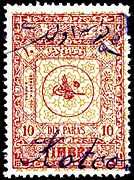Underprint

An underprint is anything printed underneath the main design of a stamp, banknote or similar item. Underprinting is used as a security measure to prevent forgery or the cleaning of a postmark from a used stamp.[1] The most common form of underprinting is burelage which takes the form of a feint pattern of lines or dots. Underprinting may also take the form of single or repeating words, for instance the word CUSTOMS at one time appeared underprinted on British revenue stamps.[2]
Printing on the back
The term has also been used in philately to refer to advertising or other wording printed on the back of postage stamps[3] but that is thought to be an incorrect[4] use of the term, with the word backprint being seen as more correct.[5]
Gallery
-

A 1918 5 Rupees banknote of India showing an underprinted 5.
-

This telephone stamp of Monaco includes the underprinted repeating words POSTESETTTELEGRAPHSTELEPHONES.
-

A yellow repeating burelage underprint may be seen on this 1912 revenue stamp of Turkey.
-

British embossed revenue stamps underprinted CUSTOMS.
See also
References
| Wikimedia Commons has media related to Security underprints on stamps. |
- ↑ Mackay, James. Stamp Collecting: Philatelic Terms Illustrated. 4th edition. London: Stanley Gibbons, 2003, p. 161. ISBN 0852595573
- ↑ Barefoot, John., ed. Great Britain Revenues. 4th edition. York: J. Barefoot Ltd., 2002, pp. 39-41. ISBN 0906845629
- ↑ Protective Overprints and Underprints. Andy Donaldson, 2000-2013. Retrieved 27 June 2013. Archived here
- ↑ Patrick, Douglas & Mary. The Hodder Stamp Dictionary. London: Hodder & Stoughton, 1973, p. 254. ISBN 0340171839
- ↑ Sutton, R.J. & K.W. Anthony. The Stamp Collector's Encyclopaedia. 6th edition. London: Stanley Paul, 1966, p. 318.